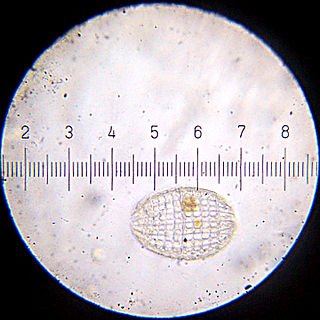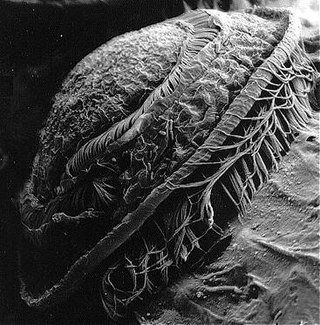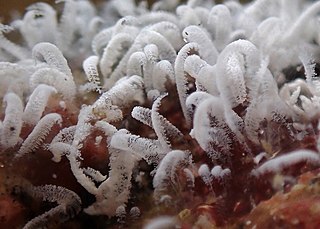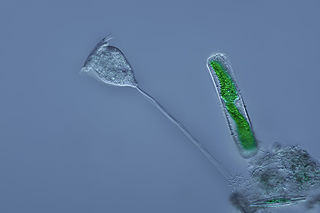| Sessilida | |
|---|---|
 | |
| Zoothamnium niveum | |
| Scientific classification | |
| Domain: | |
| (unranked): | |
| (unranked): | |
| Phylum: | |
| Subphylum: | |
| Class: | |
| Subclass: | |
| Order: | Sessilida Stein, 1833 |
| Families | |
Sessilida is the largest order of the peritrich ciliates. [1] [2]
| Sessilida | |
|---|---|
 | |
| Zoothamnium niveum | |
| Scientific classification | |
| Domain: | |
| (unranked): | |
| (unranked): | |
| Phylum: | |
| Subphylum: | |
| Class: | |
| Subclass: | |
| Order: | Sessilida Stein, 1833 |
| Families | |
Sessilida is the largest order of the peritrich ciliates. [1] [2]

The heterotrichs are a class of ciliates. They typically have a prominent adoral zone of membranelles circling the mouth, used in locomotion and feeding, and shorter cilia on the rest of the body. Many species are highly contractile, and are typically compressed or conical in form. These include some of the largest protozoa, such as Stentor and Spirostomum, as well as many brightly pigmented forms, such as certain Blepharisma.

The peritrichs are a large and distinctive group of ciliates.

The Litostomatea are a class of ciliates. The group consists of three subclasses: Haptoria, Trichostomatia and Rhynchostomatia. Haptoria includes mostly carnivorous forms such as Didinium, a species of which preys primarily on the ciliate Paramecium. Trichostomatia (trichostomes) are mostly endosymbionts in the digestive tracts of vertebrates. These include the species Balantidium coli, which is the only ciliate parasitic in humans. The group Rhynchostomatia includes two free-living orders previously included among the Haptoria, but now known to be genetically distinct from them, the Dileptida and the Tracheliida.

Blepharisma is a genus of unicellular ciliate protists found in fresh and salt water. The group includes about 40 accepted species, and many sub-varieties and strains. While species vary considerably in size and shape, most are easily identified by their red or pinkish color, which is caused by granules of the pigment blepharismin.
Karyorelictea is a class of ciliates in the subphylum Postciliodesmatophora. Most species are members of the microbenthos community, that is, microscopic organisms found in the marine interstitial habitat, though one genus, Loxodes, is found in freshwater.

Prostomatea is a class of ciliates. It includes the genera Coleps and Pelagothrix.

The ciliates are a group of alveolates characterized by the presence of hair-like organelles called cilia, which are identical in structure to eukaryotic flagella, but are in general shorter and present in much larger numbers, with a different undulating pattern than flagella. Cilia occur in all members of the group and are variously used in swimming, crawling, attachment, feeding, and sensation.

Climacostomum is a genus of unicellular ciliates, belonging to the class Heterotrichea.

Dileptus is a genus of unicellular ciliates in the class Litostomatea. Species of Dileptus occur in fresh and salt water, as well as mosses and soils. Most are aggressive predators equipped with long, mobile proboscides lined with toxic extrusomes, with which they stun smaller organisms before consuming them. Thirteen species and subspecies of Dileptus are currently recognized.

Mobilida is a group of parasitic or symbiotic peritrich ciliates, comprising more than 280 species. Mobilids live on or within a wide variety of aquatic organisms, including fish, amphibians, molluscs, cnidarians, flatworms and other ciliates, attaching to their host organism by means of an aboral adhesive disk. Some mobilid species are pathogens of wild or farmed fish, causing severe and economically damaging diseases such as trichodinosis.

Armophorea is a class of ciliates in the subphylum Intramacronucleata. . It was first resolved in 2004 and comprises three orders: Metopida, Clevelandellida, and Armophorida. Previously members of this class were thought to be heterotrichs because of similarities in morphology, most notably a characteristic dense arrangement of cilia surrounding their oral structures. However, the development of genetic tools and subsequent incorporation of DNA sequence information has led to major revisions in the evolutionary relationships of many protists, including ciliates. Metopids, clevelandellids, and armophorids were grouped into this class based on similarities in their small subunit rRNA sequences, making them one of two so-called "riboclasses" of ciliates, however, recent analyses suggest that Armophorida may not be related to the other two orders.
Wilbertomorphidae is a family of karyorelictean ciliates. The family is monotypic, because it contains a single genus Wilbertomorpha with a single known species, Wilbertomorpha colpoda.

Licnophora is a genus of ciliates in the family Licnophoridae. They typically have an hourglass-like shape and live as ectocommensals on marine animals.

Zoothamnium is a genus of ciliate protozoan.
Parablepharismea is a class of free-living marine and brackish anaerobic ciliates that form a major clade of obligate anaerobes within the SAL group, together with the classes Muranotrichea and Armophorea.

Vorticellidae is a family of ciliates belonging to the order Sessilida. They are colonial or unicellular organisms that are attached to a substrate via a stalk. The distinguishing characteristic of the family is a helical spasmoneme within the stalk that is contractile.

Trachelocercidae is a family of ciliates in the class Karyorelictea.
Urostylida is an order of littoral ciliates. The taxonomy of the order is largely unresolved and still subject to scientific inquiry.

Ventrata is an infraphylum of ciliates inside the subphylum Intramacronucleata that unites the classes Phyllopharyngea, Colpodea, Nassophorea, Prostomatea, Plagiopylea and Oligohymenophorea. It is equivalent to the clade CONthreeP or Conthreep recovered by phylogenetic analyses.
Blepharismidae is a family of unicellular ciliate protists found in fresh and salt water. Two genera are recognized: Blepharisma, which contains some model organisms, and Pseudoblepharisma